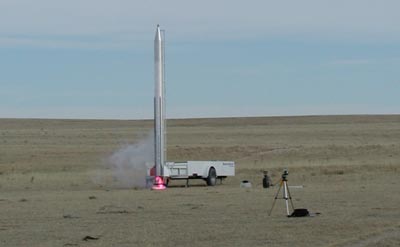Rebutting the regulatory mythby Joe Latrell
|
| I can tell you that from a commercial side I have plenty of regulations to deal with, thank you, and from a myriad of governmental agencies. |
First I have to make sure that the vehicle is sound. The vehicle must have safety features on board to minimize the possibility of an accident. As with an airplane, we have a critical design review where engineers get to look at the design and make suggestions and poke and prod at the rocket. You must justify and explain every nut, bolt, and screw on the rocket and the way it was manufactured. It is not the most pleasant experience, but it is required.
Next, the launch procedures must undergo a safety check. The vehicle’s flight path must be approved by the FAA. This covers everything from declaring a suitable launch site through the landing area and every point in between—airplanes generally do not have to worry about instantaneous impact points at every moment of a flight. The “what if” scenarios are mind-boggling in the levels of detail they contain. And all of this is for unmanned rockets. No one has licensed a viable passenger vehicle so far, beyond SpaceShipOne and XCOR Aerospace’s unbuilt design.
Just for the record, I would like to point out that the FAA is one of the best agencies to work with. They really are trying to help get the space industry off the ground, so to speak.
| The reality is that rocketry, like the airline industry, has its share of regulations to contend with. They may not be as detailed as the airline industry at the moment, but they are there. |
Furthermore, the EPA has regulations for the safe handling of the fuels and covers what, if anything, needs to be done in the event of a spill at takeoff or landing. They also cover proper storage of the materials when we are not flying. Where and how things are placed fall under their looking glass. There are regulations for what we can carry, too. These are also under the EPA regulations.
Some of our rockets use solid motors. Enter the BATFE (Bureau of Alcohol, Tobacco, Firearms and Explosives). We have to have a permit to buy motors, buy chemicals, and to make motors or igniters. Plus the added bonus of random inspection to make certain our storage facilities are in compliance.
And if that is not enough, there are also the spaceport regulations, the county and state regulations, Department of Transportation regulations, and more.
I could go on and on. The reality is that rocketry, like the airline industry, has its share of regulations to contend with. They may not be as detailed as the airline industry at the moment, but they are there. Both the government and the rocket companies are working to ensure safety without stifling the industry. To dismiss aerospace regulation as virtually non-existent is to trivialize the difficulty of it all.
